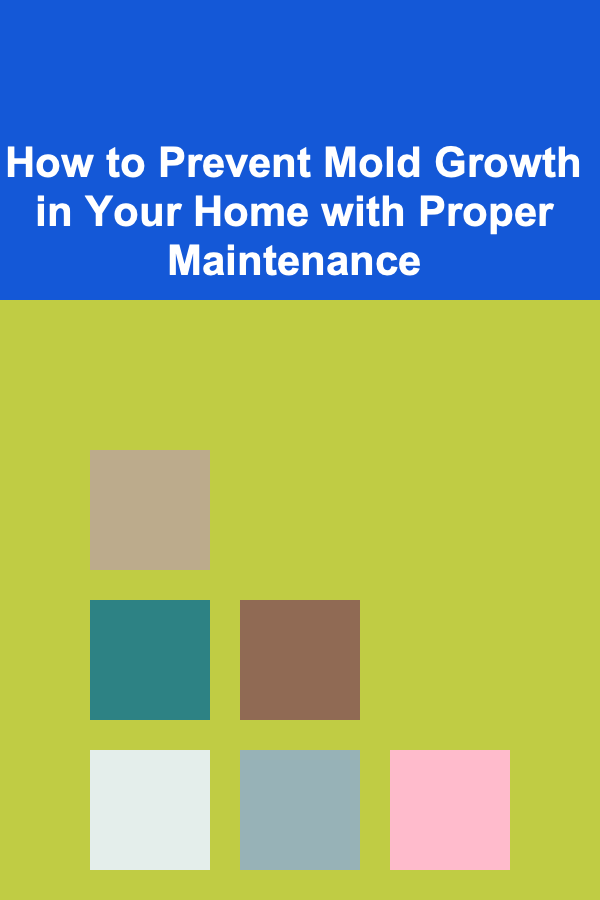
How to Prevent Mold Growth in Your Home with Proper Maintenance
ebook include PDF & Audio bundle (Micro Guide)
$12.99$11.99
Limited Time Offer! Order within the next:

Mold growth is a common problem in homes, particularly in areas with high humidity or water exposure. It can cause serious damage to structures, compromise indoor air quality, and even lead to health issues. Mold thrives in damp, warm environments, making it essential to understand how to prevent mold growth and maintain a clean and healthy living space. In this article, we will explore the causes of mold growth, the health risks associated with mold, and the importance of proper home maintenance to prevent mold development.
What is Mold and How Does it Grow?
Mold is a type of fungus that grows in the form of multicellular filaments, known as hyphae. It thrives in moist, dark, and poorly ventilated environments. Mold spores are present in the air around us at all times, but they only start to grow when they find the right conditions: sufficient moisture, organic material to feed on, and the right temperature range.
Mold grows rapidly in areas where there is excess moisture, such as bathrooms, kitchens, basements, or places with water leaks. Once mold spores land on a suitable surface, they begin to reproduce, forming colonies that can spread across walls, ceilings, floors, and even furniture.
Common Causes of Mold Growth in Homes
Understanding the causes of mold growth is the first step in preventing it. Here are some common factors that contribute to mold problems in homes:
1. Excess Moisture
Mold thrives in environments with excess moisture. This moisture can come from various sources, including:
- Leaks: Plumbing leaks, roof leaks, or leaks in windows and doors allow water to seep into walls and floors, providing a perfect breeding ground for mold.
- Condensation: When warm, moist air meets cold surfaces, condensation forms. This can occur on windows, pipes, and even walls, creating the moisture mold needs to grow.
- Flooding: Heavy rains or natural disasters like hurricanes can lead to flooding, which introduces a significant amount of water into your home, promoting mold growth if not addressed quickly.
- High Humidity: High humidity levels, particularly in basements, bathrooms, or attics, increase the risk of mold growth.
2. Poor Ventilation
Without proper ventilation, moisture in the air cannot escape. This can cause excess moisture to build up, especially in enclosed spaces like bathrooms, kitchens, and basements. Poor airflow is a major contributor to mold growth, as it allows humid air to stagnate and condense on surfaces, encouraging mold spores to settle and grow.
3. Water Damage
Water damage from leaks, floods, or even spills can leave moisture trapped inside materials such as drywall, wood, and carpeting. These materials are highly susceptible to mold growth when they remain damp for extended periods.
4. Building Materials and Conditions
The materials used in the construction of your home can also contribute to mold growth. For example:
- Porous materials like wood, drywall, and carpets are more likely to absorb moisture and provide food for mold.
- Improper insulation can create areas of high humidity where condensation forms, especially in walls, attics, or basements.
5. Lack of Maintenance
Homes that lack proper maintenance, such as blocked gutters, improperly sealed windows, or faulty HVAC systems, are more prone to mold problems. Regular maintenance ensures that any potential mold hazards are identified and addressed before they become serious issues.
The Health Risks of Mold
Mold is not just an aesthetic concern; it can also pose serious health risks to those living in the affected areas. Mold releases spores and mycotoxins that can cause allergic reactions and respiratory issues. People with asthma, respiratory conditions, or weakened immune systems are particularly vulnerable to mold exposure.
1. Respiratory Problems
Mold spores can be inhaled into the lungs, causing irritation to the airways. This can lead to coughing, wheezing, shortness of breath, and chest tightness. Prolonged exposure can exacerbate respiratory conditions like asthma and chronic bronchitis.
2. Allergic Reactions
Mold is a known allergen, and exposure to mold spores can trigger allergic reactions in sensitive individuals. Symptoms may include sneezing, runny nose, itchy eyes, skin rashes, and sinus congestion.
3. Toxic Effects
Certain types of mold, particularly black mold (Stachybotrys chartarum), can produce mycotoxins, which are toxic compounds that can affect the nervous system, liver, and kidneys. Long-term exposure to these mycotoxins can lead to more severe health problems, including fatigue, headaches, dizziness, and even memory loss.
4. Weakened Immune System
People with compromised immune systems, such as those undergoing chemotherapy or living with HIV/AIDS, are more susceptible to fungal infections caused by mold exposure. Mold can also increase the risk of fungal infections in individuals who are already ill or weakened.
How to Prevent Mold Growth in Your Home
Preventing mold growth requires proactive efforts to control moisture levels, improve ventilation, and maintain your home. Here are several key strategies to help keep mold at bay:
1. Control Moisture Levels
The most important step in preventing mold growth is controlling moisture in your home. Here are a few ways to manage moisture:
- Fix leaks promptly: Inspect your plumbing, roof, and windows regularly for leaks. Repair any leaks as soon as they are discovered to prevent water from seeping into walls, ceilings, or floors.
- Dry wet areas quickly: If any areas of your home get wet due to spills, flooding, or leaks, dry them out as quickly as possible. Use fans, dehumidifiers, and towels to absorb moisture and prevent it from seeping into building materials.
- Use a dehumidifier: Dehumidifiers are effective at reducing humidity in your home, especially in high-moisture areas like basements and bathrooms. Aim for a humidity level of 30-50% to discourage mold growth.
- Use moisture-absorbing products: Silica gel, activated charcoal, and other moisture-absorbing products can help absorb excess humidity in closed spaces like closets or cabinets.
2. Improve Ventilation
Proper ventilation helps moisture escape and prevents it from building up in enclosed spaces. Here are a few tips to improve airflow in your home:
- Use exhaust fans: In areas prone to high humidity, such as bathrooms and kitchens, use exhaust fans to help remove moisture from the air. Make sure the fans are vented to the outside and not into the attic or walls.
- Open windows: Whenever possible, open windows to allow fresh air to circulate throughout your home. This is especially important after activities that produce moisture, such as cooking or showering.
- Install vents: In areas like attics or crawlspaces, install vents to promote airflow and prevent moisture from accumulating. Make sure these vents are unobstructed and functioning properly.
- Air circulation: Ensure that air can circulate freely around your home, especially in areas where moisture is likely to accumulate. Avoid overcrowding or blocking air vents and ducts.
3. Inspect and Maintain Your Home Regularly
Regular inspections and maintenance are essential to keeping mold at bay. Look for signs of mold or moisture damage and address them immediately.
- Check your gutters: Clean gutters regularly to prevent water from overflowing and spilling onto the foundation. Clogged gutters can lead to water damage in your roof, walls, and basement.
- Inspect windows and doors: Ensure that windows and doors are properly sealed to prevent water from entering your home. Check caulking around windows, doors, and trim for cracks and wear.
- Maintain your HVAC system: Clean your air conditioning and heating units regularly to ensure they are functioning properly and not spreading mold spores. Replace filters as needed and inspect ducts for any mold buildup.
- Seal cracks and gaps: Inspect your home for cracks in walls, floors, or foundations that could allow water to enter. Seal any gaps around pipes, vents, or windows to prevent water intrusion.
4. Use Mold-Resistant Products
When building or renovating, consider using mold-resistant materials to prevent mold growth:
- Mold-resistant drywall: Specially designed drywall can help reduce the risk of mold growth in areas with high humidity.
- Mold-resistant paint: Some paints contain antimicrobial properties that help prevent mold growth on walls and ceilings.
- Water-resistant flooring: Consider using materials like tile, vinyl, or concrete flooring in areas prone to moisture. These materials are less likely to absorb water and encourage mold growth.
5. Handle Water Damage Promptly
If your home experiences water damage, it's essential to act quickly to prevent mold from taking hold:
- Remove water immediately: Use pumps, towels, or wet vacuums to remove standing water as soon as possible.
- Dry affected areas: Use fans, dehumidifiers, and heaters to dry out wet areas quickly. Aim to reduce moisture levels within 24 to 48 hours to prevent mold from developing.
- Dispose of damaged materials: If materials like carpets, drywall, or insulation have absorbed water and are beyond repair, dispose of them to prevent mold growth.
Conclusion
Mold is a common problem that can be prevented with proper maintenance and proactive measures. By controlling moisture, improving ventilation, and maintaining your home, you can reduce the likelihood of mold growth and ensure a healthier, safer living environment. Regular inspections and prompt action in case of leaks or water damage are key to preventing mold-related issues. With these steps, you can protect your home from mold and avoid the potential health risks and structural damage that mold can cause.
Reading More From Our Other Websites
- [Home Staging 101] How to Stage a Bathroom for a Luxury Feel
- [Tiny Home Living Tip 101] How to Create a Pet‑Friendly Tiny Home Without Sacrificing Space
- [Home Renovating 101] How to Plan a Home Renovation for Maximum Flow and Functionality
- [Organization Tip 101] How to Create a Summer Camp Packing List for Kids
- [Home Security 101] How to Protect Yourself from Identity Theft with Smart Security Practices
- [Home Pet Care 101] How to Train Your Dog to Walk on a Leash Without Pulling
- [Home Renovating 101] How to Update Your Home's Insulation During Renovation
- [Organization Tip 101] How to Collaborate with Neighbors for a Block Yard Sale
- [Home Family Activity 101] How to Master Water Balloon Games for the Backyard: Splashing Fun and Safety Tips
- [Ziplining Tip 101] How to Plan a Multi‑Day Zipline Expedition Across Southeast Asia

Affordable Thrifty Pantry Organization Ideas for Every Home
Read More
How to Use Mindfulness to Improve Financial Decisions
Read More
How to Utilize Vertical Space for Collectibles
Read More
How to Create a Volunteer Recruitment Strategy for Your Non-Profit
Read More
10 Tips for Designing a Kid-Friendly Living Room
Read More
10 Tips for Staying Warm While Snowboarding
Read MoreOther Products

Affordable Thrifty Pantry Organization Ideas for Every Home
Read More
How to Use Mindfulness to Improve Financial Decisions
Read More
How to Utilize Vertical Space for Collectibles
Read More
How to Create a Volunteer Recruitment Strategy for Your Non-Profit
Read More
10 Tips for Designing a Kid-Friendly Living Room
Read More